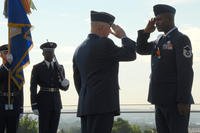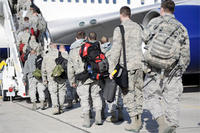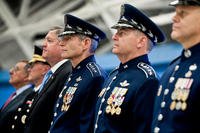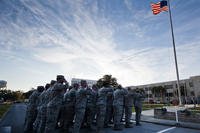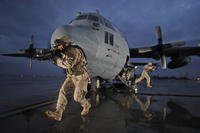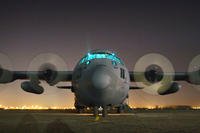Early Years
On Aug. 1, 1907, the U.S. Army Signal Corps established a small Aeronautical Division to take "charge of all matters pertaining to military ballooning, air machines and all kindred subjects."
The Signal Corps began testing its first airplane at Fort Myer, Va., on Aug. 20, 1908, and on Sept. 9, Lt. Thomas E. Selfridge, flying with Orville Wright, was killed when the plane crashed. He was the first military aviation casualty. After more testing with an improved Wright Flyer, the Army formally accepted this airplane, identified as "Airplane No. 1," on Aug. 2, 1909.
In early 1913, the Army ordered its aviators who were training in Augusta, Ga., and Palm Beach, Fla., to Texas to take part in 2d Division maneuvers. In Galveston on March 3, the Chief Signal Officer designated the assembled men and equipment the "1st Provisional Aero Squadron," with Capt Charles DeF. Chandler as squadron commander.
The 1st Provisional Aero Squadron began flying activities a few days later. On Dec. 4, general orders redesignated the unit as the 1st Aero Squadron, effective Dec. 8, 1913. This first military unit of the U.S. Army devoted exclusively to aviation, today designated the 1st Reconnaissance Squadron, has remained continuously active since its creation. Assigned a role in the Punitive Expedition of the Mexican border in 1916, this squadron became the first air combat unit of the U.S. Army.
Meanwhile, Congress created in the Signal Corps an Aviation Section to replace the Aeronautical Division. Signed by the President, this bill became law on July 18, 1914. It directed the Aviation Section to operate and supervise "all military [U.S. Army] aircraft, including balloons and aeroplanes, all appliances pertaining to said craft, and signaling apparatus of any kind when installed on said craft."
- The section would also train "officers and enlisted men in matters pertaining to military aviation," and thus embraced all facets of the Army's air organization and operation.
- The old Aeronautical Division continued to exist, but operated as the Washington office of the new section.
When World War I broke out in Europe in August 1914, the 1st Aero Squadron represented the entire tactical air strength of the U.S. Army. It counted 12 officers, 54 enlisted men and six aircraft. In December 1915 the Aviation Section consisted of 44 officers, 224 enlisted men and 23 airplanes--still a tiny force when compared to the fledgling air forces of the European powers.
But the war in Europe focused more attention on aviation.
By this time the Aviation Section consisted of the Aeronautical Division, the Signal Corps Aviation School at San Diego, the 1st Aero Squadron (then on duty with the expeditionary force in Mexico), and the 1st Company, 2d Aero Squadron, on duty in the Philippines. In October 1916, Aviation Section plans called for two dozen squadrons--seven for the Regular Army, 12 for the National Guard divisions, and five for coastal defense -- plus balloon units for the field and coast artillery. In December 1916 the seven Regular Army squadrons either had been or were being organized. All 24 squadrons had been formed by early 1917, but the 1st Aero Squadron remained the only one fully organized and equipped. Plans for still greater expansion of the Aviation Section were incomplete when the United States entered World War I on April 6, 1917.
World War I
On May 20, 1918, President Woodrow Wilson issued an executive order transferring aviation from the Signal Corps to two agencies under the Secretary of War: the Bureau of Aircraft Production, headed by Mr. John D. Ryan, and the Division of Military Aeronautics, directed by Maj. Gen. William L. Kenly.
On May 24 the War Department officially recognized these two Army agencies as the Air Service of the U.S. Army. Three months later, on Aug. 27, the President appointed Mr. Ryan Director of the Air Service and Second Assistant Secretary of War.
The dispersal of aero squadrons among various Army organizations during the war made it difficult to coordinate aerial activities, which led to the creation of higher echelon organizations. At the front, squadrons with similar functions were formed into groups, the first organized in April 1918 as I Corps Observation Group. The following month the 1st Pursuit Group was formed, and in July 1918 the American Expeditionary Forces organized its first aircraft unit higher than a group--the 1st Pursuit Wing--made up of the 2d and 3d Pursuit Groups and, later, the 1st Day Bombardment Group. In November 1918 the AEF possessed 14 groups (seven observation, five pursuit and two bombardment).
Following the armistice, demobilization of the Air Service was rapid and thorough.
At war's end the Air Service possessed 185 aero squadrons; 44 aero construction; 114 aero supply, 11 aero replacement, and 150 spruce production squadrons; 86 balloon companies; six balloon group headquarters; 15 construction companies; 55 photographic sections; and a few miscellaneous units.
By Nov. 22, 1919, all had been demobilized except one aero construction, one aero replacement, and 22 aero squadrons, 32 balloon companies, 15 photographic sections, and a few miscellaneous units. Between Nov.11, 1918 and June 30, 1920, officer strength plummeted from 19,189 to 1,168, and enlisted strength dropped from 178,149 to 8,428.
Following World War I, the strength of the Air Service matched what Congress considered satisfactory for peacetime.
Between Wars
The Army Reorganization Act of 1920 made the Air Service a combatant arm of the Army and gave the Chief of the Air Service the rank of major general and his assistant chief the rank of brigadier general. Tactical air units in the United States were placed under the nine U.S. Army corps area commanders where they continued to be employed primarily in support of the ground forces. The Chief of the Air Service retained command of various training schools, depots and other activities exempted from Army corps control.
During most of the 1920s, the total offensive strength of the Air Service in the United States consisted of one pursuit, one attack and one bombardment group. Overseas, the Canal Zone and the Philippines each had assigned one pursuit and one bombardment squadron with two squadrons of each type stationed in the Hawaiian Islands. The Air Service focused initially on observation and pursuit aviation, with major aeronautical development efforts concentrated in the Engineering Division at McCook Field, Dayton, Ohio.
The formal training establishment took shape during the 1920s. The Air Service concentrated flying training in Texas. Technical schools for officers and enlisted men were at Chanute Field, Ill. The Air Service (later, Air Corps) Tactical School trained officers to command higher units and taught the employment of military aviation. First located at Langley Field, Va., this school moved to Maxwell Field, Ala. in 1931.
The Air Corps Act of 1926 changed the name of the Air Service to Air Corps, but left unaltered its status as a combatant arm of the U.S. Army.
The act also established the Office of Assistant Secretary of War for Air. The Air Corps had at this time 919 officers and 8,725 enlisted men, and its "modern aeronautical equipment" consisted of 60 pursuit planes and 169 observation planes; total serviceable aircraft of all types numbered less than 1,000.
In August 1926 the Army established the Air Corps Training Center in San Antonio, Texas. A few weeks later, on Oct. 15, the logistical organization was placed on firmer footing with the establishment of the Materiel Division, Air Corps, at Dayton, Ohio. A year later this division moved to nearby Wright Field, thereafter the primary base for air logistics.
On March 1, 1935, the General Headquarters Air Force, which had existed in gestation since Oct.1, 1933, became operational and assumed command and control over Air Corps tactical units. Tactical units, less some observation squadrons scattered throughout the nine Army corps areas, transferred to this initial air force.
The three GHQAF wings were located at Langley Field, Va.; Barksdale Field, La.; and March Field, Calif. The Office of the Chief of the Air Corps and GHQAF existed on the same command echelon, each reporting separately to the Army Chief of Staff. The GHQAF Commander directed tactical training and operations, while the Chief of the Air Corps maintained control over procurement, supply, training schools and doctrine development. On March 1, 1939, the Chief of the Air Corps assumed control over the GHQAF, centralizing command of the entire air arm.
President Franklin D. Roosevelt acknowledged the growing importance of airpower, recognized that the United States might be drawn into a European war. Assured of a favorable reception in the White House, the Air Corps prepared plans in October 1938 for a force of some 7,000 aircraft.
Soon afterwards, President Roosevelt asked the War Department to prepare a program for an Air Corps composed of 10,000 airplanes, of which 7,500 would be combat aircraft.
In a special message to Congress on January 12, 1939, the President formally requested this program. Congress responded on April 3, authorizing $300 million for an Air Corps "not to exceed 6,000 serviceable airplanes."
World War II
Beginning in September 1939, the German army and the German air force rapidly conquered Poland, Norway, Holland, Belgium, France and within one year had driven the British off the continent. Leaders of the Air Corps now found themselves in the novel position of receiving practically anything they requested. Plans soon called for 54 combat groups. This program was hardly underway before revised plans called for 84 combat groups equipped with 7,800 aircraft and manned by 400,000 troops by June 30, 1942. All told, U.S. Army air forces strength in World War II would swell from 26,500 men and 2,200 aircraft in 1939 to 2,253,000 men and women and 63,715 aircraft in 1945.
Both necessity and desire thus caused a blitz of organizational changes from 1940 through 1942. On November 19, 1940, the General Headquarters Air Force was removed from the jurisdiction of the Chief of the Air Corps and given separate status under the commander of the Army Field Forces. Seven months later, these air combat forces returned to the command of air leaders as Gen. George C. Marshall, U.S. Army Chief of Staff, established the Army Air Forces on June 20, 1941, to control both the Air Corps and the Air Force Combat Command.
Early in 1941, the War Department instituted a series of actions to create a hierarchy for noncombat activities. It set up a command eventually designated Flying Training Command to direct new programs for training ground crews and technicians. The next year, the new command assumed responsibility for pilot and aircrew training. In mid-1942 the War Department established the Air Corps Ferrying Command to fly aircraft overseas for delivery to the British and other Allies. As the functions of the Ferrying Command expanded, it was redesignated as the Air Transport Command.
The War Department reorganization on March 9, 1942, created three autonomous U.S. Army Commands: Army Ground Forces, Services of Supply (later, in 1943, Army Service Forces), and Army Air Forces. This administrative reorganization did not affect the status of the Air Corps as a combatant arm of the US Army.
Before 1939 the Army's air arm was a fledgling organization; by the end of the war the Army Air Forces had become a major military organization comprised of many air forces, commands, divisions, wings, groups, and squadrons, plus an assortment of other organizations.
Rapid demobilization of forces immediately after World War II, although sharply reducing the size of the Army Air Forces, left untouched the nucleus of the postwar United States Air Force (USAF). A War Department letter of March 21, 1946, created two new commands and redesignated an existing one: Continental Air Forces was redesignated Strategic Air Command, and the resources of what had been Continental Air Forces were divided among Strategic Air Command and the two newcomers - Air Defense Command and Tactical Air Command. These three commands and the older Air Transport Command represented respectively the strategic, tactical, defense, and airlift missions that provided the foundation for building the postwar, independent Air Force.
An Independent Force
The National Security Act of 1947 became law on July 26, 1947. It created the Department of the Air Force, headed by a Secretary of the Air Force.
Under the Department of the Air Force, the act established the United States Air Force, headed by the Chief of Staff, USAF. On Sept. 18, 1947, W. Stuart Symington became Secretary of the Air Force, and on Sept. 26, Gen. Carl A. Spaatz became the USAF's first Chief of Staff.




